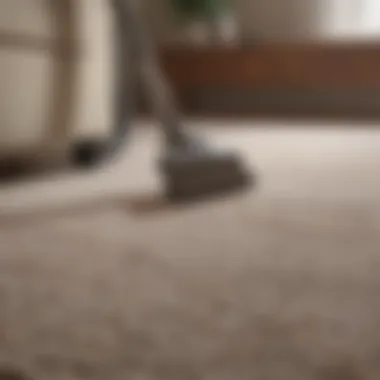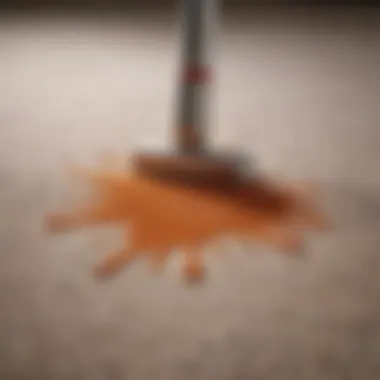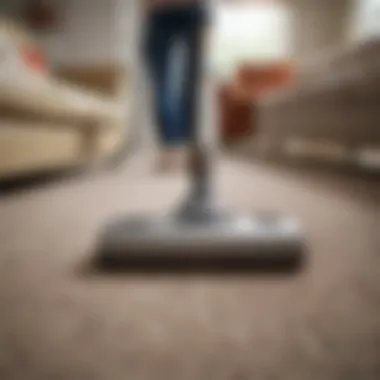Comprehensive Guide to Cleaning Living Room Carpets


Intro
Maintaining a clean living room carpet is essential for both aesthetics and hygiene. Carpets absorb dirt, dust, and spills, making them prone to stains and unpleasant odors. An effective cleaning strategy ensures not only the longevity of the carpet but also a healthier living environment.
In this guide, we will explore various methods to address typical carpet cleaning challenges. Starting with preparations, we will detail step-by-step instructions for different types of stains. Furthermore, we will discuss practical maintenance tips to extend the life of your carpet. Understanding these techniques can empower homeowners, whether seasoned or new, to handle carpet care confidently.
Foreword to Carpet Care
Cleaning carpets may appear to be a mundane task, yet it carries significant importance in maintaining not only the aesthetic appeal of your living space but also ensuring a healthy environment. Carpets act as filters, trapping allergens, dust, and dirt. Ignoring regular care can lead to buildup that may aggravate health issues, such as asthma or allergies.
Engaging in proper carpet care goes beyond keeping your home looking tidy; it prolongs the lifespan of your carpet, saving you from costly replacements. Recognizing the type of material and appropriate cleaning methods can enhance your cleaning efforts and, ultimately, your satisfaction with your living area. Choosing suitable techniques helps in retaining the vibrancy of the carpet fibers while addressing stains effectively.
Both novice and experienced homeowners benefit significantly from understanding carpet maintenance. A clean carpet not only feels good underfoot but also ensures a welcoming atmosphere for guests or family. It is essential to implement cleaning routines and practices after every significant occurrence, such as spills or heavy foot traffic. This preventive approach minimizes the risk of damage and facilitates easier cleaning in the long run.
In this guide, we will explore key components, tools, and methods that fall within carpet care. This thorough insight aids in fostering an understanding of why each step is crucial and how it contributes to maintaining the beauty and hygiene of your living room carpet.
"A well-maintained carpet is a cornerstone of a clean home, ensuring comfort and a sense of pride in your space."
In the following sections, be prepared to dive deeper into the varying aspects of carpet cleaning, from identifying fabrics to engaging in the proper cleaning techniques. This knowledge will empower you to keep your carpets looking their best and your home feeling fresh.
Understanding Carpet Materials
Understanding carpet materials is essential in the process of cleaning and maintaining your living room carpet. Different materials have unique characteristics that affect their durability, texture, and the types of cleaning methods suitable for them. Knowing these elements can help homeowners choose the right products and techniques to keep their carpets looking pristine.
Carpet materials are typically divided into two main categories: natural fibers and synthetic fibers. Natural fibers, such as wool and cotton, often provide a soft feel and superior breathability. However, they can be more susceptible to stains and generally require specialized cleaning methods. On the other hand, synthetic fibers like nylon, polyester, and olefin are more durable and stain-resistant, making them popular choices for high-traffic areas.
When choosing carpet materials, consider the following factors:
- Durability: How well will it withstand heavy use?
- Stain Resistance: Is it easy to clean and maintain?
- Comfort: Does it feel pleasant underfoot?
- Cost: Is it within budget?
Understanding these factors allows homeowners to make informed decisions tailored to their specific needs.
Common Carpet Fabrics
Wool
Wool is an excellent choice for those seeking natural warmth and luxury. It has natural insulating properties that provide comfort during cold seasons. Well-known for being resilient, wool carpets can bounce back from compression, making them ideal for areas with high foot traffic. However, they need careful cleaning, as they can absorb moisture and stains easily.
Nylon
Nylon is one of the most popular synthetic carpet materials. It offers a unique blend of strength and softness, giving it an appealing texture. This material is also highly resistant to wear and tear, making it suitable for households with pets or children. Moreover, nylon carpets tend to resist stains effectively with proper treatment, making maintenance simpler.
Polyester
Polyester carpets are known for their vibrant colors and affordability. They are softer than nylon but less durable. While they can resist fading and stains to an extent, they may not withstand heavy foot traffic as well as nylon or wool. Regular maintenance will help prolong the life of polyester carpets.
Olefin
Olefin, or polypropylene, is another synthetic material known for its resistance to moisture, mold, and mildew. This feature makes it ideal for areas that may be prone to dampness. While olefin may not offer the same level of comfort as other fibers, it remains a popular choice due to its durability and easy cleaning.
Choosing the Right Cleaning Method
Choosing the right cleaning method is pivotal for maintaining the aesthetic and functionality of your carpet. The cleaning solution or technique you utilize can either enhance or damage the fabric. Here are some points to keep in mind:
- Identify the Material: Before cleaning, identify whether your carpet is made of natural or synthetic fibers. This will determine appropriate cleaning agents and methods.
- Read Care Instructions: Always check the manufacturer’s guidelines, as they often provide specific recommendations for cleaning.
- Test Cleaning Solutions: Apply your chosen cleaner on a small, inconspicuous area first. This will prevent any unexpected discoloration or damage.
Employing the right cleaning method can preserve the carpet's appearance and enhance its lifespan. Understanding which technique works best for specific stains and types of carpet will ensure comprehensive care.
"A well-maintained carpet not only enhances your living space but also contributes to a healthier home environment."


For deeper insights into carpet care, visit Wikipedia or check Britannica for historical context.
In summary, comprehending carpet materials, their characteristics, and the right cleaning methods are foundational skills for any homeowner seeking to maintain their living room carpets effectively.
Essential Tools for Carpet Cleaning
Cleaning a living room carpet effectively demands the right set of tools. These tools are vital not just for achieving cleanliness but for maintaining the longevity of the carpet itself. With the right instruments, one can handle various stains, dirt types, and fabric materials. Moreover, using appropriate tools minimizes the risk of damage to the carpet fibers and helps maintain its aesthetic and functional qualities.
Vacuum Cleaners
Vacuum cleaners are essential for carpet care. A powerful vacuum removes surface dirt and allergens that may accumulate. There are many types of vacuum cleaners available, such as upright, canister, and robotic models. Each has its pros and cons.
- Upright Vacuums: Generally effective for larger areas. Many come with rotating brushes, which help lift dirt from deep within the fibers.
- Canister Vacuums: More versatile, ideal for reaching tight spaces and corners. They provide good suction and can work well on various floor types.
- Robotic Vacuums: Convenient for regular maintenance. Though they may not match traditional models in suction power, they assist in daily upkeep.
A vacuum should ideally have a HEPA filter to trap tiny particles, enhancing indoor air quality. Regular vacuuming is essential, ideally once a week, to prevent the buildup of dirt and allergens.
Cleaning Solutions
Cleaning solutions come in various formulations, each tailored to a specific purpose. It is crucial to choose the right product that matches the carpet material and stain type. Here are common options:
- Commercial Carpet Cleaners: Available in both spray and liquid formats. They can effectively treat various stains without damaging the carpet.
- Natural Cleaners: Mixtures using vinegar or baking soda can work wonders on light stains. Such cleaners are often less harsh on the environment and safer for households with pets and children.
- Spot Cleaners: These are designed specifically for targeted stain treatment. They can be beneficial in emergency situations when a quick solution is required.
It is essential to read labels carefully to ensure the solution is safe for your carpet type. Testing a small inconspicuous area before applying any cleaning solution is a prudent practice.
Stain Removal Tools
Stain removal tools come in handy for tackling specific incidents promptly. A few must-have tools include:
- Blotting Cloths: Microfiber cloths are ideal for blotting spills without spreading the stain and are effective for absorbing liquids.
- Stiff Brush: For raising carpet fibers and working cleaning solutions into the carpet's surface. This is useful for scrub cleaning when necessary, especially for textured carpets.
- Specialized Applicators: Tools like spray bottles and spoons can assist in controlled application of cleaning solutions.
Having dedicated tools for stain removal can save time and maintain the carpet's integrity.
"Investing in quality cleaning tools signifies a commitment to carpet maintenance and ensures long-lasting results."
In summary, having the right tools at your disposal not only streamlines the cleaning process but also enhances the effectiveness of your efforts. By incorporating these essential tools into your cleaning routine, you position yourself for a cleaner, more hygienic living space.
Preparing for Carpet Cleaning
Preparing for carpet cleaning is an essential step that sets the stage for effective results. This phase helps optimize the cleaning process, ensuring that every action taken is purposeful and efficient. By properly preparing your living room carpet, you not only make the task easier but also improve the longevity of your carpet.
Clearing the Area
Before commencing any cleaning, it's crucial to clear the area. This means removing furniture, decor, and items that may obstruct your cleaning path. Not only does this prevent damage to your belongings, but it also allows for a thorough clean.
When furniture is left in place, dirt and substances can accumulate in those hidden areas, leading to localized staining and odors. Taking the time to clear the space enables you to access every inch of the carpet.
- Consider using furniture sliders. These help move heavier items without scratching the floor.
- Remember to protect your walls or any delicate surfaces from accidental scuffs during the process.
A clean area allows for effective vacuuming and spot treatment, ensuring that you're not just pushing dirt around.
Testing Cleaning Solutions
Testing cleaning solutions is a vital step in the carpet cleaning preparation process. Not all carpets react the same way to cleaning chemicals, so it’s prudent to test a small, inconspicuous area before applying any solution generously. This helps identify the formulation that is most effective without causing damage to the fibers.
- Select a small spot. Choose an area that is hidden, like under a couch or behind a door.
- Apply the solution according to the instructions on the label and monitor any immediate reaction.
- Wait and observe. Check how the dye or fabric reacts after a few minutes. There should be no discoloration or adverse effects.
This precautionary measure not only safeguards your carpet but also provides an opportunity to determine the best cleaning method for your specific needs.
"Preparation is the key to unlocking the potential of your carpet cleaning efforts."


Before diving into the cleaning process, these preparatory steps ensure you approach the task with confidence and clarity. Each part of preparation builds a foundation for a successful carpet cleaning experience.
Step-by-Step Cleaning Process
The cleaning process for living room carpets is crucial in maintaining both their appearance and longevity. A systematic approach helps to ensure that all aspects of carpet care are addressed effectively. By following a detailed step-by-step method, one can achieve not just a cleaner carpet but also a more hygienic living environment. The benefits of a thorough cleaning process include improved air quality, increased carpet lifespan, and the removal of hidden allergens and bacteria.
Deep Cleaning Techniques
Deep cleaning is essential for removing dirt and grime that accumulate over time. This process involves cleaning deeper than regular vacuuming permits. One effective method is using a carpet cleaning machine, which can be rented from many home improvement stores. These machines typically employ hot water and a cleaning solution that penetrates the fibers, loosening embedded dirt.
Another technique involves using a foam or gel cleaner, which is applied and then brushed into the carpet. After allowing the solution to work its magic for a short time, it is then vacuumed up. This method can be effective for heavy traffic areas that require extra attention. It is advised to clean carpets at least once every six months, ensuring they remain vibrant and free of allergens.
Spot Cleaning for Stains
Spot cleaning is the first line of defense against stubborn stains. Immediate action is critical when a spill occurs. First, blot the area gently with a clean cloth, avoiding any scrubbing that could push the stain deeper into the carpet fibers. For food or drink stains, a solution of mild detergent and warm water is often effective. Apply the solution with a clean cloth and blot until the stain lifts.
It is important to avoid using bleach or harsh chemicals unless specified for the type of stain. Test any cleaning solution on an inconspicuous area first. This ensures that it will not discolor the carpet. The key to successful spot cleaning is addressing the stain quickly and using minimal moisture to avoid a new set of problems, such as mold or odor development.
Steam Cleaning Methods
Steam cleaning is another highly effective method for deep cleaning carpets. This process uses steam to loosen dirt and kill bacteria. Steam cleaners can often be rented or purchased, providing a cost-effective way to rejuvenate carpets.
To begin, the carpet should be vacuumed thoroughly to remove surface debris. The steam cleaner is then filled with water, and a small amount of detergent is added if necessary. It's important to follow the manufacturer's instructions regarding water temperature and cleaning solution.
The steam should be applied in a slow, consistent manner to ensure that it penetrates deeply. Allow the carpet to dry completely afterward. This may take several hours, so plan the cleaning during a time when the area can remain undisturbed. Regular steam cleaning can significantly enhance not just the cleanliness but also the appearance of the carpet, restoring its original texture and color.
"A clean carpet is not just about aesthetics but also about maintaining a healthy home environment."
Addressing Specific Stains
Addressing specific stain types is crucial in carpet maintenance. Stains can significantly affect carpet's appearance and texture. Different stains require unique handling techniques, which, when applied correctly, can restore the carpet’s original look. Furthermore, timely intervention can prevent permanent damage. Understanding how to treat stains ensures longer carpet life and maintains the room's overall hygiene.
Removing Food and Drink Stains
Food and drink spills are common incidents in a living room setting. Such stains can vary widely, influenced by the nature of the substance. For example, juices can leave behind sticky residues, while sauces may introduce oily components.
When tackling food stains, act quickly:
- Blot the excess: Use a clean cloth or paper towel to absorb as much of the spill as possible. Avoid rubbing, as it can worsen the stain.
- Apply a cleaning solution: Mix a few drops of dish soap, a cup of white vinegar, and warm water. Test this on a small area first. Gently apply it with a cloth.
- Blot again: After a few minutes, blot the area with a clean cloth to absorb the solution. Repeat if necessary until the stain vanishes.
This method is effective for many food products, including ketchup, mustard, and various other sauces.
Handling Pet Accidents
Pet accidents are perhaps one of the most challenging types of stains. Urine, for instance, can cause discoloration and odor. Before panic sets in, an effective cleaning strategy can minimize damage.
- Act fast: The quicker you clean it, the less chance of a lingering smell.
- Use a specialized pet cleaner: These solutions contain enzymes that break down urine components. They not only clean the surface but also help eliminate odors.
- Apply in layers: Spray the cleaner and let it sit. This allows the enzymes to work effectively.
- Rinse and blot: After sufficient time has passed, rinse the area with water and blot dry. This ensures your carpet doesn’t retain residual fluids.
With some diligence, carpets can stay fresh even with furry friends around.
Dealing with Grease and Oil
Grease and oil seem to almost instantaneously bookmark their territory in carpets, leaving behind unsightly marks. They are often found in kitchens, especially when cooking or snacking. Here’s how to approach greasy stains:
- Absorb the excess: If the spill is recent, sprinkle cornstarch or baking soda on it. These powders will absorb the grease.
- Scrape gently: Using a knife edge, carefully lift the powder with grease. Do not push down; this can push grease deeper.
- Cleaning solution: Mix warm water with a few drops of dish soap and gently scrub the area with a cloth.
- Rinse and dry: Like before, it’s essential to rinse the area after treating it and then blot dry.
These steps are beneficial even for older stains that may have set over time.
Remember, addressing stains specific to their type not only cleans the surface but also ensures longer carpet durability in the long run.


This section aims to give you practical solutions for common yet troublesome stains found in living rooms. Implementing these techniques can lead to a cleaner and more inviting home.
Drying and Maintenance
Drying and maintenance are crucial aspects in the realm of carpet care. Proper drying prevents the growth of mold and mildew, which can lead to unpleasant odors and health concerns. When carpets are damp for extended periods, they become a welcoming space for various unwanted organisms. Furthermore, regular maintenance routines keep carpets looking fresh and prolong their lifespan. A well-maintained carpet not only enhances the aesthetics of the living room but also contributes to a healthier environment. Below, we will delve into effective drying methods and routine maintenance practices that every homeowner should adopt.
Proper Drying Methods
After a thorough cleaning, ensuring that the carpet dries correctly is essential. Here are several methods to achieve optimal drying:
- Air Drying: If possible, open windows and doors to promote airflow. This method is slow but eco-friendly.
- Fans: Using fans can significantly speed up the drying process. Position them strategically to circulate air across the wet area.
- Dehumidifiers: In humid weather, employ a dehumidifier. It helps in removing excess moisture from the air while maintaining optimal drying conditions.
- Heat: If safe, use a heater at a low setting to warm up the room. Warm air absorbs moisture more effectively than cold air.
When using heat, always monitor the carpet to avoid damage or discoloration. Keeping the humidity under control is essential during drying.
Regular Maintenance Routines
To maintain a carpet's appearance and functionality, homeowners should establish consistent maintenance routines. Here are some effective practices:
- Regular Vacuuming: Aim to vacuum carpets at least once a week. This helps remove dirt, dust, and allergens, contributing to a healthier environment. For high-traffic areas, consider more frequent sessions.
- Spot Clean Immediately: The sooner you address spills or stains, the easier they will be to remove. Utilize appropriate cleaning solutions specific to the type of stain.
- Professional Cleaning: Schedule professional deep cleaning every 12-18 months. Professional services can effectively extract dirt and stains that everyday cleaning may miss.
- Rotate Furniture: Move furniture occasionally to avoid uneven wear. It helps in maintaining the carpet's integrity while preventing imprints.
By integrating these drying and maintenance steps, you can significantly improve the longevity and appearance of your living room carpet. Not only does this create a more inviting space, but it also safeguards your investment in your home.
Preventative Measures for Carpet Longevity
Taking measures to prolong the life of your carpet is just as important as cleaning it. Preventative measures can save you time, effort, and money in the long run. When properly maintained, carpets contribute positively to the overall aesthetic and hygiene of the living environment. Preventative measures work to minimize wear and tear, reduce staining risks, and maintain the carpet's appearance. Being proactive can extend the durability of your carpet, ensuring it looks good for years to come.
Using Area Rugs
Area rugs can serve as a protective layer over your carpet. They act as barriers against dirt, spills, and heavy foot traffic. Strategically placing area rugs can reduce the direct contact of shoes with your carpet. This helps limit the accumulation of dirt particles and allergens.
Additionally, area rugs come in various designs and colors, which can enhance the overall decor of your living room. They can also provide an opportunity to refresh the look of the space without the need for a complete carpet replacement. When choosing area rugs, consider options that are easy to clean and maintain.
- Placement: Position area rugs in high-traffic zones, like in front of sofas or entryways.
- Material: Opt for durable materials that resist wear, such as synthetic fibers or wool.
Implementing a No-Shoes Policy
A no-shoes policy is an effective strategy for maintaining the cleanliness and longevity of your carpet. Shoes track in dirt, debris, and germs from outside, ultimately leading to premature wear of the carpet fibers. By encouraging family members and guests to remove their shoes upon entering, you significantly reduce the amount of contaminants that come into contact with the carpet.
This policy not only keeps carpets cleaner but can also create a more welcoming atmosphere in your home. Providing comfortable slippers or indoor shoes can help guests feel at ease while respecting your carpet care standards.
- Benefits of No-Shoes Policy:
- Reduces dirt and debris buildup
- Minimizes staining potential
- Extends carpet life significantly
Removing shoes is a simple yet effective change that can yield substantial benefits for your carpet’s longevity.
"Implementing these preventative measures can create a cleaner, healthier living environment while prolonging the life of your investment."
By following these guidelines, you set the stage for a carpet that remains vibrant and comfortable for a long time. The commitment to care and maintain will pay off in the end.
The End
In this comprehensive guide, we explored the intricate details of cleaning living room carpets. Understanding the importance of proper carpet care can significantly enhance both the aesthetic appeal and longevity of your flooring. Carpets serve as the foundation of your living space, affecting not only the overall ambiance but also the hygiene level in your home.
Cleaning your carpet regularly and correctly can prevent the buildup of dirt and allergens. This includes knowing the right tools to use, such as vacuum cleaners and appropriate cleaning solutions, tailored to your specific carpet type. Moreover, it is critical to address stains promptly to avoid permanent damage.
The benefits of maintaining your carpet go beyond mere appearance. A clean carpet contributes to a healthier environment by reducing dust mites and other irritants that can affect air quality. Thus, following a structured cleaning regimen is essential for any homeowner.
In addition to cleaning techniques, preventative measures are crucial. Using area rugs, implementing a no-shoes policy, and incorporating regular maintenance routines can greatly extend the life of your carpet.
By synthesizing the information from this guide, homeowners can take proactive steps towards a cleaner and more inviting living space. A well-maintained carpet is more than just a luxury; it's an investment in your home's comfort and cleanliness.
"A clean carpet is the heart of a healthy home.
In summary, prioritize carpet care and apply the insights gained from this article to ensure your living room remains a welcoming and pristine area in your home.







